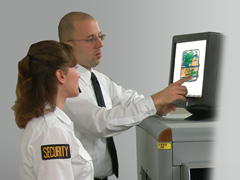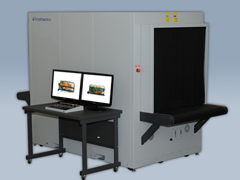 In the aviation security world, conventional X-ray systems are still the dominant technology used to screen baggage and cargo. The technology is proven, stable, and holds up well to the operational demands of an airport. However, one of the biggest challenges for screeners is trying to interpret what’s inside a passenger’s baggage using a ‘flat’ or two-dimensional (2D) image.
In the aviation security world, conventional X-ray systems are still the dominant technology used to screen baggage and cargo. The technology is proven, stable, and holds up well to the operational demands of an airport. However, one of the biggest challenges for screeners is trying to interpret what’s inside a passenger’s baggage using a ‘flat’ or two-dimensional (2D) image.
As three-dimensional (3D) X-ray systems continue to improve, we can expect more of them to be widely deployed at airports. Meanwhile, X-ray screeners will have to learn how to shift from 2D to 3D X-ray interpretation.
Conventional X-ray Systems
 Conventional X-ray systems create a two-dimensional representation of a three-dimensional object. Similarly, photographs create 2D representations of 3D objects. However, photos use shadows, shading, and other pictorial depth cues to reveal the third dimension.
Conventional X-ray systems create a two-dimensional representation of a three-dimensional object. Similarly, photographs create 2D representations of 3D objects. However, photos use shadows, shading, and other pictorial depth cues to reveal the third dimension.
X-rays which are transparent images of volumes do not have the same pictorial cues and can often result in the misinterpretation of spatial relationships. X-ray equipment manufacturers have attempted to overcome this issue by creating dual-view systems that provide different projection angles and supplying software packages that provide material discrimination.
Advancement in 3D X-ray Technology
Advances in technology are now starting to allow for true 3D imaging. Computed Tomography (CT), which has been used in the medical field for years, has been adapted for use in aviation security. Similar to CT is Real Time Tomography that uses multiple X-ray sources to create a 3D image that is fully volumetric.
These provide screeners with a more natural view of a passenger’s bag. It is still an X-ray image, but it contains volume and depth much like our world around us. The technology is becoming very stable and reliable and it is gaining traction in many airports around the world.
Skills Required for 3D Image Interpretation
It will be challenging for screeners to make the transition from conventional X-ray systems to 3D X-ray systems. Unlike 2D X-ray images that are static and non-rotational, each object in a 3D X-ray image has a relative depth and position. This requires some additional skills to interpret 3D X-ray images correctly.
Visual spatial ability is one critical skill. Because the 3D X-ray images are volumetric, a screener needs to be able to mentally rotate objects around the x-axis (horizontal), y-axis (vertical) and z-axis (depth). The screener needs to be able to understand whether they are looking at the front, top, bottom, or backside of any object.
Object depth localization is another skill that will prove useful to screeners interpreting 3D X-ray images. Again, because 3D X-ray images are fully volumetric, understanding where an object is located in the X-ray image and how to determine if one object is closer than another is important.
For example, in a 2D X-ray image we might have an organic mass, a set of ear buds, and an alarm clock all in the same image. Because of the 2D view, they may all appear to be together and could possibly represent an Improvised Explosive Device.
In a 3D view, a screener should be able to determine the relative position of each object as well as the full volumetric shape. This may show that the objects are not together and with proper spatial ability, the screener may determine none of the items are dangerous.
Airport deployment of 3D X-ray machines can be expected to expand as the technology improves. When this happens, training will become a very important factor in migrating screeners from 2D X-ray systems to 3D X-ray systems.
What do you think about 3D technology in aviation? Provide your comments and questions below.
